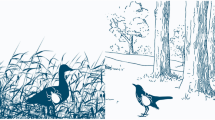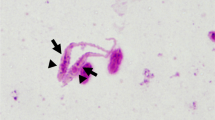Abstract
Brown dog ticks are distributed world-wide, and their systematics and phylogeny are the subject of an ongoing debate. The present study evaluates the reproductive compatibility between Rhipicephalus sanguineus ticks from North America, Israel, and Africa. Female ticks of the parent generation were mated with males from the same and alternate colonies. Every pure and hybrid cohort was maintained separately into the F2 generation with F1 females being allowed to mate only with males from the same cohort. The following survival parameters were measured and recorded for every developmental stage: feeding duration and success; engorgement weight, fertility, and fecundity of females; molting and hatching success. Ticks from North American and Mediterranean populations hybridized successfully. The survival parameters of all their hybrid lines were similar to those in pure lines throughout the F1 generation, and F1 adults were fully fertile. Parent adult ticks from the African population hybridized with either North American or Mediterranean ticks and produced viable progenies whose survival parameters were also similar to those in pure lines throughout the F1 generation. However, F1 adults in the four hybrid lines that included African ancestry were infertile. No parthenogenesis was observed in any pure or hybrid lines as proportion of males in F1 generation ranged from 40 to 60 %. Phylogenetic analysis of the 12S rDNA gene sequences placed African ticks into a separate clade from those of the North American or Mediterranean origins. Our results demonstrate that Rh. sanguineus ticks from North America and Israel represent the same species, whereas the African population used in this study is significantly distant and probably represents a different taxon.

Similar content being viewed by others
References
Anderson JF (2002) The natural history of ticks. Med Clin North Am 86:205–218
Baker SC (1998) Distinguishing species and populations of rhipicephaline ticks with ITS 2 ribosomal RNA. J Parasitol 84:887–892
Balashov YS (1970) Experimental interspecific hybridization between Ornithodoros papillipes ornithodoros-Tartakovskyi and Ornithodoros verrucosus (Argasidae: Ixodoidea)] [Russian]. Parazitologiya 4:274–282
Balashov YS, Grigor’eva LA, Oliver J (1998) Reproductive isolation and interspecific hybridization in ixodid ticks of the Ixodes ricinus—I. persulcatus group (Acarina, Ixodidae). Entomol Rev 78:500–508
Beati L, Keirans JE (2001) Analysis of the systematic relationships among ticks of the genera Rhipicephalus and Boophilus (Acari: Ixodidae) based on mitochondrial 12S ribosomal DNA gene sequences and morphological characters. J Parasitol 87:32–48
Burlini L, Teixeira KRS, Szabó MPJ, Famadas KM (2010) Molecular dissimilarities of Rhipicephalus sanguineus (Acari: Ixodidae) in Brazil and its relation with samples throughout the world: is there a geographical pattern? Exp Appl Acarol 50:361–374
Clarke FC, Pretorius E (2005) A comparison of geometric morphometic analyses and cross-breeding as methods to determine relatedness in three Amblyomma species (Acari: Ixodidae). Int J Acarol 31:393–405
Dantas-Torres F (2008) The brown dog tick, Rhipicephalus sanguineus (Latreille, 1806) (Acari: Ixodidae): From taxonomy to control. Vet Parasitol 152:173–185
Davey RB, Osburn RL, Castillo C (1983) Longevity and mating behavior in males and parthenogenesis in females in hybridized Boophilus ticks (Acari: Ixodidae). J Med Entomol 20:614–617
Drummond RO, Ernst SE, Trevino JL, Gladney WJ et al (1973) Boophilus annulatus and B. microplus: laboratory tests of insecticides. J Econ Entomol 66:130–133
Farid HA (1996) Morphological keys for the separation of the Rhipicephalus sanguineus group of ticks (Acarina: Ixodidae) in Egypt. J Egypt Soc Parasitol 26:453–460
Feldman-Muhsam B (1952) On the identity of Rhipicephalus sanguineus lat. Bull Res Council Israel 11:187–194
Feldman-Muhsam B (1968) The Rhipicephalus sanguineus complex. WHO/VBC 68(57):113–120
Felsenstein J (1985) Confidence limits on phylogenies: an approach using the bootstrap. Evolution 39:783–791
Gladney WJ, Dawkins CC (1973) Experimental interspecific mating of Amblyomma maculatum and A. americanum. Ann Entomol Soc Am 66:1093–1097
Graham OH, Price MA, Trevino JL (1972) Cross-mating experiments with Boophilus annulatus and B. microplus (Acarina: Ixodidae). J Med Entomol 9:531–537
Hafez M, Bishara SI, Bassal TT (1981) Trials on cross-mating between three species of Rhipicephalus sanguineus group (Ixodoidea: Ixodidae). J Egypt Soc Parasitol 11:261–267
Hoogstraal H (1985) Ticks. In: Gaafar SM (ed) Animal population handbook (World Animal Science). Elsevier Sci. Publ. Co., Amsterdam, Netherlands, pp 347–369
Ioffe-Uspenskiy I, Mumcuoglu KY, Uspenskiy I, Galun R (1997) Rhipicephalus sanguineus and Rh. turanicus (Acari:Ixodidae): closely related species with different biological characteristics. J Med Entomol 34:74–81
Ketchum HR, Teel PD, Coates CJ, Strey OF, Longnecker MT (2009) Genetic variation in 12S and 16S mitochondrial rDNA genes of four geographically isolated populations of Gulf Coast ticks (Acari: Ixodidae). J Med Entomol 46:482–489
Labruna MB, Naranjo V, Mangold AJ, Thompson C et al (2009) Allopatric speciation in ticks: genetic and reproductive divergence between geographic strains of Rhipicephalus (Boophilus) microplus. Bmc Evol Biol 9:46
Labruna MB, Soares JF, Martins TF, Soares HS et al (2011) Cross-mating experiments with geographically different populations of Amblyomma cajennense (Acari: Ixodidae). Exp Appl Acarol 54:41–49
Leo SS, Pybus MJ, Sperling FAH (2010) Deep mitochondrial DNA lineage divergences within Alberta populations of Dermacentor albipictus (Acari: Ixodidae) do not indicate distinct species. J Med Entomol 47:565–574
Matsumoto K, Brouqui P, Raoult D, Parola P (2005) Experimental infection models of ticks of the Rhipicephalus sanguineus group with Rickettsia conorii. Vector Borne Zoonotic Dis 5:363–372
Mayr E (1970) Populations, species, and evolution. Belknap Press of Harvard University Press, Cambridge, p 472
Moraes-Filho J, Marcili A, Nieri-Bastos FA, Richtzenhain LJ et al (2011) Genetic analysis of ticks belonging to the Rhipicephalus sanguineus group in Latin America. Acta Trop 117:51–55
Mtambo J, Madder M, Van Bortel W, Berkvens D et al (2007) Rhipicephalus appendiculatus and R. zambeziensis (Acari: Ixodidae) from Zambia: a molecular reassessment of their species status and identification. Exp Appl Acarol 41:115–128
Müller S, Boulouis HJ, Viallard J, Beugnet F (2004) Epidemiological survey of canine bartonellosis to Bartonella vinsonii subs. berkhoffii and canine monocytic ehrlichiosis in dogs on the Island of Reunion. Revue de Medecine Veterinaire 155:377–380
Oliveira PR, Bechara GH, Denardi SE, Saito KC et al (2005) Comparison of the external morphology of Rhipicephalus sanguineus (Latreille, 1806) (Acari: Ixodidae) ticks from Brazil and Argentina. Vet Parasitol 129:139–147
Oliver JH (1989) Biology and systematics of ticks (Acari: Ixodida). Annu Rev Ecol Sys 20:397–430
Oliver JH, Wilkinson PR, Kohls G (1972) Observations on hybridization of three species of North American Dermacentor ticks. J Parasitol 58:380–384
Pegram RG, Clifford CM, Walker JB, Keirans JE (1987a) Clarification of the Rhipicephalus sanguineus group (Acari, Ixodoidea, Ixodidae). I. R. sulcatus Neumann, 1908 and Rh. turanicus Pomerantsev, 1936. Syst Parasitol 10:3–26
Pegram RG, Keirans JE, Clifford CM, Walker JB (1987b) Clarification of the Rhipicephalus sanguineus group (Acari, Ixodoidea, Ixodidae). II. Rh. sanguineus (Latreille, 1806) and related species. Syst Parasitol 10:27–44
Pegram RG, Zivkovic D, Jongejan J (1989) Ticks (Acari ixodoidea) of the Yemen Arab Republic II. The Rhipicephalus sanguineus (Latreille) group. Bull Entomol Res 79:259–263
Pervomaisky GS (1950) Interspecific hybridization of Ixodidae (Russian). Dokl Akad Nauk SSSR 73:1033–1036
Rechav Y, Norval RAI, Oliver JH (1982) Interspecific mating of Amblyomma hebraeum and Ambtyomma variegatum (Acari: Ixodidae). J Med Entomol 19:139–142
Saitou N, Nei M (1987) The neighbor-joining method: a new method for reconstructing phylogenetic trees. Mol Biol Evol 4:406–425
Spickett AM, Malan JR (1978) Genetic incompatibility between Boophilus decoloratus (Koch, 1844) and Boophilus microplus (Canestrini, 1888) and hybrid sterility of Australian and South African Boophilus microplus (Acarina: Ixodidae). Onderstepoort J Vet Res 45:149–153
Szabo MPJ, Mangold AJ, Joao CF, Bechara GH et al (2005) Biological and DNA evidence of two dissimilar populations of the Rhipicephalus sanguineus tick group (Acari: Ixodidae) in South America. Vet Parasitol 130:131–140
Tamura K, Nei M, Kumar S (2004) Prospects for inferring very large phylogenies by using the neighbor-joining method. Proc Natl Acad Sci USA 101:11030–11035
Tamura K, Dudley J, Nei M, Kumar S (2007) MEGA4: Molecular evolutionary genetics analysis (MEGA) software version 4.0. Mol Biol Evol 24:1596–1599
Troughton DR, Levin ML (2007) Life cycles of seven ixodid tick species (Acari: Ixodidae) under standardized laboratory conditions. J Med Entomol 44:732–740
Walker JB, Keirans JE, Horak IG(2000) The genus Rhipicephalus (Acari, Ixoidae). A guide to the brown ticks of the World. Cambridge University Press, Cambridge, UK, 643 pp
Zahler M, Gothe R (1997) Evidence for the reproductive isolation of Dermacentor marginatus and Dermacentor reticulatus (Acari: Ixodidae) ticks based on cross-breeding, morphology and molecular studies. Exp Appl Acarol 21:685–696
Zahler M, Gothe R, Rinder H (1995) Diagnostic DNA amplification from individual tick eggs, larvae and nymphs. Exp Appl Acarol 19:731–736
Zahler M, Filippova NA, Morel PC, Gothe R et al (1997) Relationships between species of the Rhipicephalus sanguineus group: a molecular approach. J Parasitol 83:302–306
Zivkovic D, Pegram RG, Jongejan F, Mwase ET (1986) Biology of Rhipicephalus appendiculatus and R. zambeziensis and production of a fertile hybrid under laboratory conditions. Exp Appl Acarol 2:285–298
Acknowledgments
E.A. Studer was supported by The Oak Ridge Institute for Science and Education (ORISE). We are grateful to Dr. Pablo Tortosa of the Centre de Recherche et de Veille sur les Maladies Emergentes dans l’Océan Indien for providing Rh. sanguineus ticks from Reunion Island for this study.
Author information
Authors and Affiliations
Corresponding author
Additional information
The findings and conclusions described in this article are those of the authors and do not necessarily represent the views of the Centers for Disease Control and Prevention and the Department of Health and Human Services.
Rights and permissions
About this article
Cite this article
Levin, M.L., Studer, E., Killmaster, L. et al. Crossbreeding between different geographical populations of the brown dog tick, Rhipicephalus sanguineus (Acari: Ixodidae). Exp Appl Acarol 58, 51–68 (2012). https://doi.org/10.1007/s10493-012-9561-x
Received:
Accepted:
Published:
Issue Date:
DOI: https://doi.org/10.1007/s10493-012-9561-x




